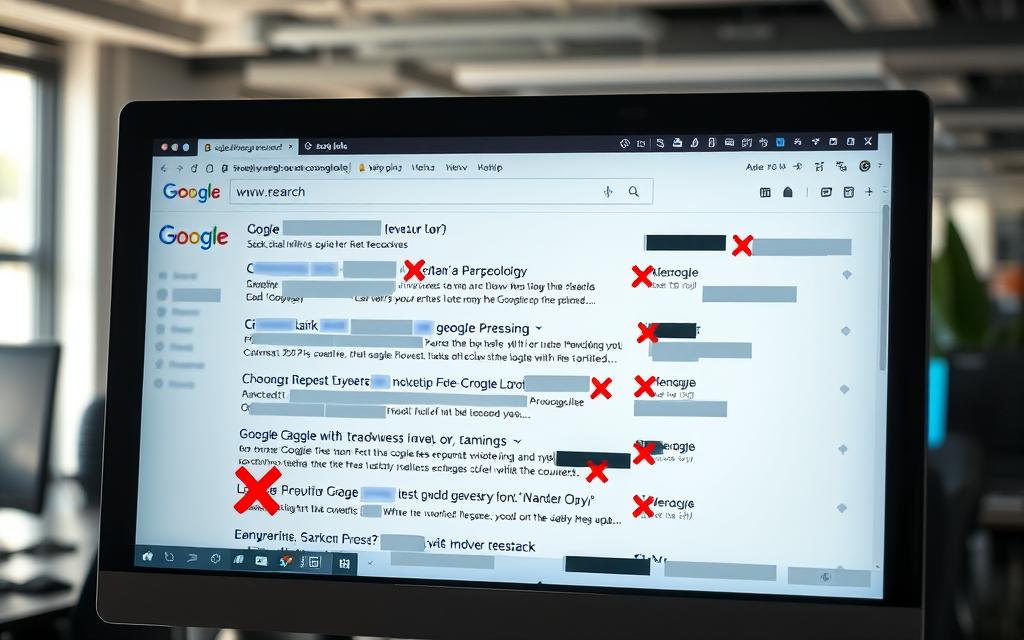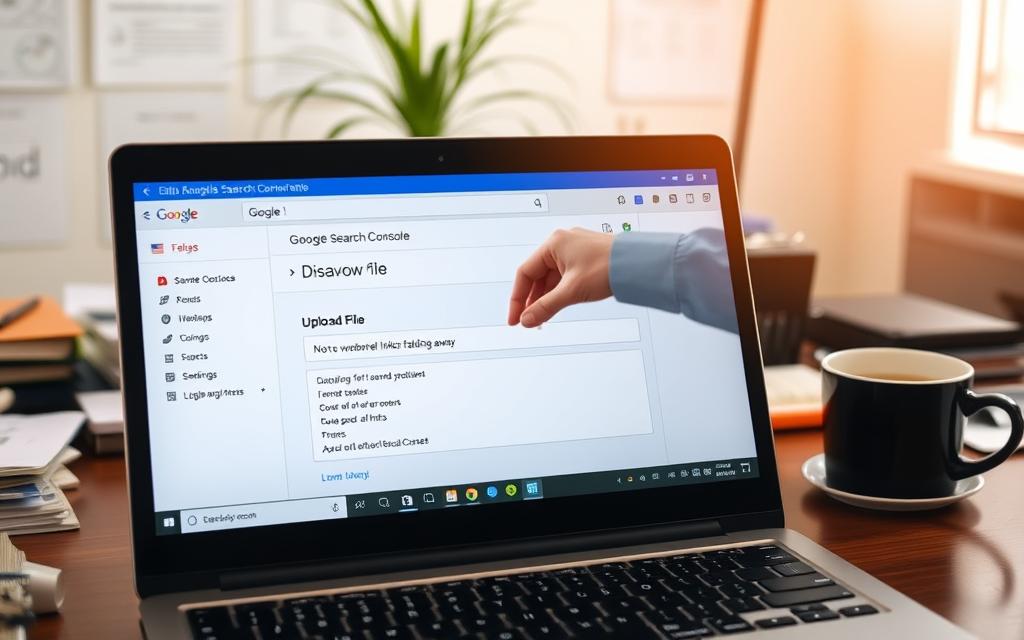Your online reputation is crucial. A single negative search result can harm your chances and how others see you. Luckily, Reputation Return offers a quick and affordable way to hide hurtful links and unwanted search results. Ask for a free consultation.
Dealing with defamatory content, outdated info, or wanting to control your online image? There are strategies to push down negative search results and boost your digital footprint. This guide will show you how to effectively suppress Google search results and protect your reputation.
Key Takeaways:
- Understand the impact of negative search results and the importance of reputation management
- Learn how to determine if suppressing search results is necessary for your situation
- Discover effective techniques to create positive content and bury unwanted links
- Explore the benefits of working with professional reputation management services
- Develop a proactive approach to monitor and maintain your online reputation
Understanding the Need to Suppress Search Results
In today’s digital world, having a strong online presence is key for success. But, the ease of finding information online can also be a problem. A single negative search result can harm your reputation, costing you more than you think.
One Bad Post Can Cost You More Than You Can Imagine
A negative review can make it hard to get new clients. With online search engines, it’s easy for people to find this bad info. To keep a good reputation, it’s important to suppress negative search results and bury negative content online.
Remove Negative Content or Bury Negative Content
The best thing is to remove the negative search result. If it’s on a site you control, it’s easier. But, if it’s on a site you don’t own, like a blog or social media, it’s harder. Then, you focus on techniques to suppress negative content online and how to bury negative search results well.
“A single negative search result can have a lasting impact on your reputation, making it crucial to take action to suppress negative search results and maintain a positive online presence.”
Understanding the need to handle negative online content is key. By taking action, you can how to suppress negative search results and protect your reputation. This helps you succeed in the long run.

Determine If Suppressing Search Results Is Necessary
Managing your online reputation might mean hiding some search results. But first, you must decide if it’s really needed. Google usually knows which links to trust, so most sites don’t need to use the disavow tool.
Disavowing backlinks is only for sites with many spammy or low-quality links. These links could lead to a penalty from Google. A penalty is when Google finds unnatural linking practices.
- Most clients see negative content pushed off page one within 6-12 months with consistent effort.
- The team of Online Reputation Management experts has refined their approach over years to help clients from all industries overcome negative search results.
If you’re not sure about penalties or low-quality links, talk to a professional reputation management service. They can check your situation and suggest the best way to protect your online image.
“In a study of 4 million Google search results, only 0.63% of people clicked on the second page, highlighting the importance of the first page search results.”
Deciding to hide search results should be a careful thought. It’s about looking at your online presence and how negative content affects you. With a smart plan, you can manage your reputation well and show your brand in a good light.

Create a List of Links to Disavow
If your website has been hit by bad backlinks, it’s time to make a disavow list. This list tells Google to ignore certain links when checking your site’s ranking and reputation.
Link File Format Guidelines
Put together your list of pages or domains to ignore in a text file for Google. Here’s how to format it correctly:
- Write one URL or domain per line.
- To ignore a whole domain, start with “domain:”. For example: domain:example.com.
- The file must be in UTF-8 or 7-bit ASCII.
- It should end with .txt.
- URLs can’t be longer than 2,048 characters.
- The file can’t have more than 100,000 lines or 2MB.
Disavowing links should be a last choice in your SEO plan. Google might ignore bad links from shady SEO tactics. But, if you disavow too many, it could look like all your links are bad.
| Backlink Audit Metrics | Average |
|---|---|
| Toxic backlinks identified | 35% |
| Disavow file size (max 2MB) | 2MB |
| Time for Google to process disavow request | 3 months |
By sticking to these rules and tips, you can make a good how to create a disavow list and link file format for disavowing links. This will help your website show up better in search results and look better to Google.

Upload Your Disavow List
Cleaning up your online reputation often means submitting a disavow list to Google. This process might seem hard, but it’s doable. You can manage harmful content and boost your search visibility.
To upload your disavow list, follow a specific format and Google’s rules. Make sure your list has one URL or domain per line. Use “domain:” before domains. The file must be in UTF-8 or 7-bit ASCII and end with .txt.
- Start by making your disavow list. Use tools like Semrush to find backlinks to remove.
- Check your list to make sure it only has links you want to remove. Google might take up to 6 weeks to update.
- Upload your list to the Google Disavow Tool. It might take up to 15 minutes to process.
- Disavowing links on the domain level removes your site’s link to the site.
The disavow list only works for the specific property you upload it to. A new list will replace any old one. Disavowed links will still show in the Links report but won’t affect your site’s ranking.

By following the right steps, you can how to upload disavow list and manage your online reputation. Remember, keeping your reputation in check is an ongoing task. Regular checks and updates are key to safeguarding your brand and personal image.
Remove All Disavowals for a Property
If you’ve submitted a disavow list for a property before, you might want to remove it. Maybe your backlink profile is now clean, or you don’t need to hide certain search results anymore. The steps to cancel disavowed links are simple.
To remove all disavowals for a property, follow these steps:
- Go to the Disavow Links tool in Google Search Console.
- Select the property from the list for which you want to cancel the disavowals.
- Click the “Cancel Disavowals” button.
This action will remove the whole disavow list for the chosen property. Google will take a few weeks to recheck the web and update their index with the changes.
Remember, removing a disavow list and canceling disavowed links should be done carefully. The Google Disavow Tool is very powerful. Using it without knowing the effects can hurt your website’s ranking.
“With great power comes great responsibility.” – Uncle Ben
Before changing your disavow list, check your backlink profile well. Make sure the disavowed links are not needed anymore. Talk to an SEO expert if you’re not sure what to do.

Fire to Fire: How to Push Down Negative Search Results
If you’re dealing with negative search results, it’s time to act. The goal is to move those unwanted links down in search rankings. The good news is, you can do this with the right strategies.
Optimize Social Media Profiles
Your social media presence is a strong tool against negative search results. Make sure your profiles on Twitter, LinkedIn, Facebook, Pinterest, and Tumblr are up-to-date and show your best side. Engage with your followers, share interesting content, and build a solid online image.
By using social media’s high ranking power, you can push down those unwanted results.
Start a Blog and Update Regularly
Starting a blog and keeping it updated with quality content is another great way to boost your reputation. Write articles that show off your skills, achievements, and positive brand image. The more you share under your name, the more you can bury negative results.
Consistency is key. Keep updating your blog and social media with valuable content. This will help push down negative results and build a strong, positive online image.
If you’re not sure where to start or need help, consider working with online reputation management experts. They can guide you and create strategies to suppress negative results and enhance your online presence.
Seek Professional Assistance
Managing your online reputation can be tough. If it feels too much, it’s time to get help. Online reputation management services from ORM experts can make a big difference. They help hide negative search results and bury bad links.
Reputation management pros know how to tackle negative content fast. They also work on making your online image strong and positive. They handle everything from improving your content to building links and making legal requests.
“Maintaining a positive online reputation is crucial in today’s digital landscape, and it’s often best left to the experts. With their extensive experience and proven techniques, ORM professionals can help you regain control of your search results and protect your most valuable asset – your reputation.”
Working with a top online reputation management company means your online image is in safe hands. They create a plan to push down bad content and highlight the good. This ensures your brand or personal image shows up well in Google searches.
Don’t let bad reviews or links hurt your future. Hire online reputation management services and let the experts do the hard work. This way, you can focus on what’s important in your life or business.
Suppress Search Results
When dealing with negative content or comments online, there are many ways to manage your reputation. The goal is to make bad information less visible or even remove it from search results.
“Reverse SEO” is a common method used by top reputation management companies. Companies like Blue Ocean Global Technology use it to highlight positive content in search results. This approach helps suppress negative information.
- Disavow Harmful Links: Identify and disavow any links that are contributing to the visibility of negative content about you or your business. This helps remove those links from search engine considerations.
- Optimize Social Media Profiles: Enhance your social media profiles, ensuring they are well-optimized and present a positive image. This can help push down unfavorable search results.
- Create and Maintain a Blog: Regularly updating a blog with valuable, SEO-optimized content can effectively bury negative search results, making them less prominent.
- Utilize Online Reputation Management Tools: Leverage specialized tools and services that can help you monitor, manage, and suppress negative online content about you or your business.
By using these techniques, you can improve your online reputation. Positive information will appear more in search results. Remember, a strong online presence and proactive reputation management are key in today’s digital world.
| Technique | Description | Effectiveness |
|---|---|---|
| Disavow Harmful Links | Identify and disavow any links contributing to the visibility of negative content. | High |
| Optimize Social Media Profiles | Enhance your social media profiles to present a positive image and push down unfavorable search results. | Moderate |
| Create and Maintain a Blog | Regularly update a blog with valuable, SEO-optimized content to bury negative search results. | High |
| Utilize Online Reputation Management Tools | Leverage specialized tools and services to monitor, manage, and suppress negative online content. | High |
“Proactively managing your online reputation is crucial in today’s digital landscape.”
A strong online presence and positive reputation are vital for success. By using these techniques, you can protect and enhance your online reputation.
Consider Legal Options
Dealing with negative content online can be tough. The European Union’s General Data Protection Regulation (GDPR) lets people ask for personal info to be removed. This is if it’s no longer important or hurts their reputation. In the U.S., there are some laws that help remove false or outdated content.
If the website won’t take down the content, you might need to go to court. A court order could force the website to remove it. Finding where this content comes from can be hard. You might need to use special search tools and check different search engines.
Getting help from lawyers who know about online reputation or privacy laws is smart. They can help you make a strong case for removing harmful content. This could be because it’s wrong, outdated, or damages your reputation.
If you can’t get content removed, there are other legal steps you can take. For example, you can ask search engines to stop showing it. The goal is to find all the legal remedies for removing negative content and pursuing legal action to suppress search results. This helps protect your online image.
“The legal system can be a powerful tool in combating harmful online content, but it requires a strategic and well-informed approach. Seeking professional assistance can make all the difference in achieving the desired outcome.”
Monitor and Maintain Your Online Reputation
Building a good online image takes hard work and focus. Keep your blog or website up to date. Also, comment on other sites using your full name and surname. Starting a forum and sharing tips is a great way to show your skills and mention your name.
Research shows that around 87% of consumers read online reviews for local businesses. 73% focus on reviews from the past month. 59% check online search engines before buying, and 97% read product reviews. These facts show why keeping a good online image is crucial.
To manage your online reputation well, follow these steps:
- Keep an eye on what people say about your brand online.
- Answer negative feedback quickly and professionally.
- Ask happy customers to leave positive reviews.
- Share interesting and useful content online.
- Work with industry influencers to boost your credibility.
Remember, keeping a good online image is a constant job. Stay active and quick to respond to keep your brand in good shape.
“Customers whose social media complaints are addressed within five minutes are more likely to spend more on future purchases.”
Continuous effort and focus on [ongoing reputation monitoring] and [maintaining a positive online presence] are vital. They help protect your brand’s reputation and lead to long-term success.
The Importance of Timely Action
It’s key to act fast when negative content pops up online. If bad search results show up for you or your business, you need to act quickly. The longer these links stay, the more harm they can do to your reputation.
Negative search results can hurt a lot. They can lead to missed chances and damage your professional or personal image. The sooner you tackle these issues, the better. Waiting too long lets the problem grow, making it harder to fix your online image.
- Some SEO changes might work in hours, while others take months.
- Waiting a few weeks is wise to see how SEO changes your Google results.
- Google finds pages mainly through links from other pages it’s already crawled.
Acting fast helps lessen the harm of negative content. You can start by submitting a disavow list or improving your social media. A quick response can protect your online image.
“Prompt action is the key to effectively managing and suppressing negative search results. The longer you wait, the more entrenched the problem becomes.”
Don’t let one bad post ruin your reputation. Remember, why taking quick action is crucial and responding to negative content promptly. This way, you can keep a positive online image that shows who you really are.
Protect Your Reputation Proactively
Keeping a good online image is key. By acting early, you can safeguard your reputation. This way, what people see about you online matches your true self and achievements.
First, make sure your social media profiles are up to date. Make them public and show a professional side. Share interesting content and talk to your followers to build a strong online image.
Also, start a blog or update your website often. Good content can help hide bad stuff online. Plus, leave smart comments on other sites to boost your online standing.
| Statistic | Percentage |
|---|---|
| Over 90% of Google traffic does not click past the first page of search results | 90% |
| Businesses that face false accusations online may benefit from removing harmful search results to protect their credibility and regain the trust of potential customers | N/A |
| Negative search results can lead to lost opportunities, damaged relationships, and decreased trust from potential clients or employers | N/A |
| Over 80% of consumers go online to learn more about businesses | 80% |
| 90% of consumers report not frequenting a business with a bad reputation | 90% |
By being proactive in reputation management, you can keep your online image safe. This ensures that what others see about you is positive and true to your image.
Conclusion
Suppressing hurtful Google search results is key to protecting your online image. It’s important to know when and how to do it. By making a disavow list and using social media and content well, you can boost your digital presence.
Getting help from experts and looking into legal actions can also be smart. This way, you can handle negative content effectively. It’s all about keeping a positive online image.
Always watch your online presence closely. Act fast to remove any bad content. This helps keep your personal or business image safe.
Remember, your online presence matters a lot. Use the right tools and strategies to manage your search results. This way, you can show the world the best version of yourself.

